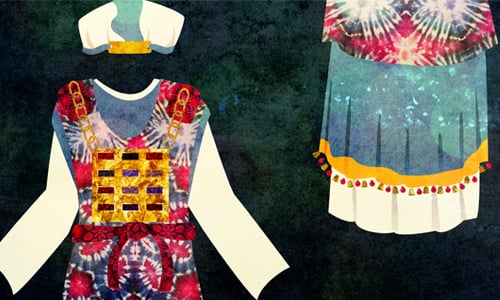 Rabbi David Etengoff Dedicated to the sacred memories of my mother, Miriam Tovah bat Aharon Hakohen, father-in-law, Levi ben Yitzhak, sister, Shulamit bat Menachem, sister-in-law, Ruchama Rivka Sondra bat Yechiel, Chana bat Shmuel, Yehonatan Binyamin ben Mordechai Meir Halevi, Shoshana Elka bat Avraham, Tikvah bat Rivka Perel, Peretz ben Chaim, Chaya Sarah bat Reb Yechezkel Shraga, Shmuel Yosef ben Reuven, Shayndel bat Mordechai Yehudah, the Kedoshim of Har Nof, Pittsburgh, and Jersey City, and the refuah shlaimah of Mordechai HaLevi ben Miriam Tovah, Yocheved Dafneh bat Dinah Zehavah, and the health and safety of our brothers and sisters in Israel and around the world. The Choshen Mishpat, worn by the Kohane Gadol, is one of the more fascinating bigdei kahuna (garments of the kohanim) that is described in our parasha: “And you [Moshe] shall make a decision breastplate (Choshen Mishpat). It shall be a patterned brocade like the ephod. Make it out of gold [thread], sky-blue, dark red and crimson wool, and twined linen.” This translation of, “decision breastplate,” derives from the placement of the Urim and Thumim therein, special stones from which prophetic communications were revealed to the Kohane Gadol: “Place the Urim and Thumim in the decision breastplate, and they shall be over Aharon’s heart when he comes before G-d. Aharon will then carry the decision-making device for the Jewish people before G-d at all times.” (Sefer Shemot 28:15, 30, translation, The Living Torah, Rabbi Aryeh Kaplan, with my emendations) In his Commentary on the Torah, Rashi (1040-1105) cites an opinion found in Talmud Bavli, Arachin 16a and Zevachin 88b, that suggests the purpose of the Choshen Mishpat is to procure atonement for error in legal decisions. (28:15) Rabbi Naftali Tzvi Yehudah Berlin (Netziv, 1816-1893) takes issue with Rashi’s approach, since “[these Talmudic sources suggest this explanation of the Choshen Mishpat] solely as an allusion and an intimation (remez v’asmachata), and as a statement that by no means represents its essential purpose.” (Ha’amek Davar, Sefer Shemot 28:15, this and the following translation and brackets my own) As such, the Netziv offers his own analysis of the inherent meaning of the Choshen Mishpat: Rather, the primary explanation of the word, “mishpat,” is to seek redress for insults against the Jewish people. [So, too, do we find] that the Targum Yonatan on Malachim I:8:49, translates “v’asita mishpatam (and You will maintain their cause),” as, “v’tit’p’rah ulbanhon (and You will seek compensation for their humiliation).” …and, therefore, the [focus on] the Choshen comes to invoke the salvation of the Jewish people and seek revenge against those who pursue them. In sum, the Netziv maintains that the role of the Choshen Mishpat is to “invoke the salvation of the Jewish people and seek revenge against those who pursue them.” In my view, this concept is evocative of the tefilah we recite each morning immediately before the recitation of the Shemoneh Esrai, wherein we beseech Hashem to bring forth the redemption of our people: “Rock of Israel, arise to the aid of Israel and liberate, as You pledged, Judah and Israel. Our Redeemer—Hashem, Master of Legions, is His Name—the Holy One of Israel. Blessed are You, Hashem, Who redeemed Israel.” (Translation, The Complete ArtScroll Siddur, page 97.) May this time come soon and, in our days, v’chane yihi ratzon. Shabbat Shalom Past drashot may be found at my blog-website: http://reparashathashavuah.org. To be added to my weekly email list, please contact me at [email protected]. *** My audio shiurim on the topics of Tefilah and Tanach may be found at: http://tinyurl.com/8hsdpyd *** I have posted 164 of Rabbi Soloveitchik’s English language audio shiurim (MP3 format) spanning the years 1958-1984. Please click on the highlighted link: The Rav
0 Comments
Leave a Reply. |
Details
Archives
July 2024
AuthorTalmid of Rabbi Soloveitchik zatzal Categories |
- Blog: Rabbi David Etengoff: Parashat HaShavuah
- Sefer Bereishit 5784&5785
- Sefer Shemot 5784&5785
- Sefer Vayikra 5784&5785
- Sefer Bamidbar 5784 &5785
- Sefer Bereishit 5782&5783
- Sefer Shemot 5782&5783
- Sefer Vayikra 5782&5783
- Sefer Bamidbar 5782&5783
- Sefer Devarim 5782&5783
- Sefer Bereishit 5780& 5781
- Sefer Shemot 5780&5781
- Sefer Vayikra 5780&5781
- Sefer Bamidbar 578&5781
- Sefer Devarim 578&5781
- Sefer Bereishit 5778&5779
- Sefer Shemot 5778&5779
- Sefer Vayikra 5778&5779
- Sefer Bamidbar 5778&5779
- Sefer Devarim 5778&5779
- Sefer Bereishit 5776&5777
- Sefer Bereishit 5774&5775
- Sefer Bereishit 5772&5773
- Sefer Bereishit 5771&5770
- Sefer Shemot 5776&5777
- Sefer Shemot 5774&5775
- Sefer Shemot 5772&5773
- Sefer Shemot 5771&5770
- Sefer Vayikra 5776&5777
- Sefer Vayikra 5774&5775
- Sefer Vayikra 5772&5773
- Sefer Vayikra 5771&5770
- Sefer Bamidbar 5776&5777
- Sefer Bamidbar 5774&5775
- Sefer Bamidbar 5772&5773
- Sefer Bamidbar 5771&5770
- Sefer Devarim 5776&5777
- Sefer Devarim 5774&5775
- Sefer Devarim 5772&5773
- Sefer Devarim 5771&5770
 RSS Feed
RSS Feed
